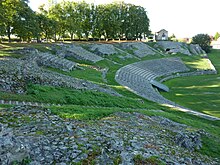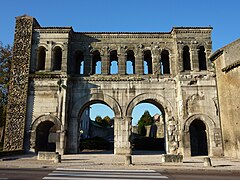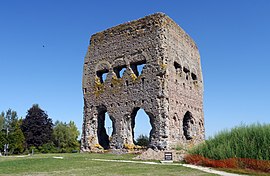Autun
Autun | |
|---|---|
Subprefecture and commune | |
From top down, left to right: Autun Cathedral, Passage de la Terrasse, Lycée militaire, Autun Theatre and City Hall, Roman-era theatre, Temple of Janus | |
| Coordinates: 46°57′06″N 4°17′58″E / 46.9517°N 4.2994°E | |
| Country | France |
| Region | Bourgogne-Franche-Comté |
| Department | Saône-et-Loire |
| Arrondissement | Autun |
| Canton | Autun-1, Autun-2 |
| Intercommunality | CC du Grand Autunois Morvan |
| Government | |
| • Mayor (2020–2026) | Vincent Chauvet[1] (MoDem) |
Area 1 | 61.52 km2 (23.75 sq mi) |
| Population (2022)[2] | 13,144 |
| • Density | 210/km2 (550/sq mi) |
| Time zone | UTC+01:00 (CET) |
| • Summer (DST) | UTC+02:00 (CEST) |
| INSEE/Postal code | 71014 /71400 |
| Elevation | 280–642 m (919–2,106 ft) |
| 1 French Land Register data, which excludes lakes, ponds, glaciers > 1 km2 (0.386 sq mi or 247 acres) and river estuaries. | |
Autun (French: [otœ̃] ⓘ) is a subprefecture of the Saône-et-Loire department in the Bourgogne-Franche-Comté region of central-eastern France. It was founded during the Principate era of the early Roman Empire by Emperor Augustus as Augustodunum to give a Roman capital to the Gallic people Aedui, who had Bibracte as their political centre. In Roman times the city may have been home to 30,000 to 100,000 people, according to different estimates.[3] Nowadays, the commune has a population of about 15,000.[4]
Pioneer of the Industrial Revolution in the nineteenth Century with the early exploitation of oil shale and fluorine, since the twentieth century, Autun has experienced a renewed dynamism that has made it the headquarters of several international companies (Dim, Nexans). It contains one of the six French military high schools (Lycée militaire d'Autun). The city, due to its ancient and medieval past, possesses a rich heritage that makes it one of the most important tourist sites in the heart of Burgundy.
Geography
The city rests on the southern edge of a depression called the Permian Autun Basin which includes the Autunian stratotype forming the Autunois. It is surrounded to the north by bocage meadows (bocage with wide mesh), to the west by the Morvan massif, and to the south by deciduous forests (domanial forest of Planoise) covering a sandstone plateau.
The Autunois region is composed of sixty-four communes grouped into seven cantons. In the cantons of Autun-Nord and Autun-Sud are the following municipalities: Antully, Auxy, Curgy, Dracy-Saint-Loup, Monthelon, Saint-Forgeot and Tavernay.
History
Early history


Augustodunum was founded during the reign of the first Roman emperor, Augustus, after whom it was named. It was the civitas "tribal capital" of the Aedui, Continental Celts who had been allies and "brothers" (fratres) of Rome since before Julius Caesar's Gallic Wars. Augustodunum was a planned foundation replacing the original oppidum Bibracte, located some 25 km (16 mi) away. Several elements of Roman architecture such as walls, gates, and a Roman theater are still visible in the town.
In AD 356, a force of Alemanni brought the siege of Autun. The disrepair of the walls left the city in danger of falling. Autun was saved by the arrival of the Emperor Julian in one of his early military successes. In Late Antiquity, Autun became famous for its schools of rhetoric. A world map based on the Geography of Ptolemy was famous for its size and was displayed in the portico of one of the schools. It may have survived until early modern times.[5]
In 532 the Merovingian kings Childebert I and Chlothar I in Battle of Autun defeated the Burgundians led by king Godomar and took over the country of Burgundy.[6] In 642 or 643, another battle was fought near Autun between feuding Frankish noblemen.
Leger (born circa 616- died 678), was bishop of Autun. He was tortured in Lucheux (Somme) on the orders of the mayor of the Ebroin Palace, who then murdered him. Around 670 he had presided over the second council of Autun (after that of 599, which was convened by Bishop Syagre).[7]
In 880, Count Richard of Autun was made the first Duke of Burgundy.
In 1506, Barthélemy de Chasseneuz made his reputation as an attorney, defending the rats of Autun against the charge of eating the barley crop.[8]
Modern times
In 1788, Charles Maurice de Talleyrand-Périgord became bishop of Autun. He was elected member of the clergy for the Estates-General of 1789.
The High School plays an important role in the history of the city and even France since Napoleon, who gave it its current name and whose brothers Joseph and Lucien studied there. This school continues to operate today. The decorated wrought iron gates were erected in 1772; the subjects taught in the school are indicated by various representations of objects along the top of these grids.
During the Franco-Prussian War of 1870, the leader of the Army of the Vosges, Giuseppe Garibaldi,[9] chose the city as his headquarters.
Climate and weather
The commune lies in the northwest of the department.
| Climate data for Autun (1991–2020 averages) | |||||||||||||
|---|---|---|---|---|---|---|---|---|---|---|---|---|---|
| Month | Jan | Feb | Mar | Apr | May | Jun | Jul | Aug | Sep | Oct | Nov | Dec | Year |
| Record high °C (°F) | 16.9 (62.4) |
20.3 (68.5) |
25.3 (77.5) |
28.2 (82.8) |
32.2 (90.0) |
36.9 (98.4) |
39.2 (102.6) |
40.0 (104.0) |
34.5 (94.1) |
28.9 (84.0) |
22.2 (72.0) |
16.8 (62.2) |
40.0 (104.0) |
| Mean daily maximum °C (°F) | 6.1 (43.0) |
7.8 (46.0) |
12.3 (54.1) |
15.8 (60.4) |
19.7 (67.5) |
23.5 (74.3) |
25.9 (78.6) |
25.8 (78.4) |
21.3 (70.3) |
16.3 (61.3) |
10.2 (50.4) |
6.6 (43.9) |
15.9 (60.6) |
| Mean daily minimum °C (°F) | −0.3 (31.5) |
−0.5 (31.1) |
1.4 (34.5) |
3.5 (38.3) |
7.5 (45.5) |
10.9 (51.6) |
12.6 (54.7) |
12.2 (54.0) |
8.6 (47.5) |
6.3 (43.3) |
2.7 (36.9) |
0.3 (32.5) |
5.4 (41.7) |
| Record low °C (°F) | −14.3 (6.3) |
−15.9 (3.4) |
−13.2 (8.2) |
−6.5 (20.3) |
−2.0 (28.4) |
0.5 (32.9) |
4.5 (40.1) |
1.7 (35.1) |
−1.2 (29.8) |
−7.9 (17.8) |
−12.0 (10.4) |
−18.3 (−0.9) |
−18.3 (−0.9) |
| Average precipitation mm (inches) | 80.7 (3.18) |
60.9 (2.40) |
60.1 (2.37) |
64.3 (2.53) |
74.9 (2.95) |
65.8 (2.59) |
60.3 (2.37) |
61.3 (2.41) |
63.1 (2.48) |
79.8 (3.14) |
91.3 (3.59) |
94.7 (3.73) |
857.2 (33.75) |
| Average precipitation days | 10.6 | 9.0 | 9.2 | 10.0 | 10.6 | 8.5 | 8.3 | 8.0 | 8.0 | 10.5 | 11.7 | 12.6 | 117.0 |
| Mean monthly sunshine hours | 67.3 | 102.5 | 161.7 | 196.6 | 209.1 | 245.4 | 261.9 | 228.0 | 191.8 | 124.1 | 71.6 | 58.5 | 1,918.4 |
| Source: Météo France[10][11] | |||||||||||||
Population
|
| ||||||||||||||||||||||||||||||||||||||||||||||||||||||||||||||||||||||||||||||||||||||||||||||||||||||||||||||||||
| Source: EHESS[12] and INSEE (1968-2017)[13] | |||||||||||||||||||||||||||||||||||||||||||||||||||||||||||||||||||||||||||||||||||||||||||||||||||||||||||||||||||
Sights
The city boasts two ancient Roman gates (Porte Saint-André and Porte d'Arroux) and other ruins dating to the time of Augustus. One of the most impressive remains is that of the ancient theatre, which was one of the largest in the western part of the empire with a 17,000-seat capacity. To the northwest of the city is the so-called Temple of Janus, only two walls (faces) of which remain. To the southeast is the mysterious Pierre de Couhard, a rock pyramid of uncertain function which may date to Roman times.

Autun Cathedral, also known as Saint Lazare Cathedral, dates from the early twelfth century and is a major example of Romanesque architecture. It was formerly the chapel of the Dukes of Burgundy; their palace was the actual episcopal residence. The cathedral was originally built as a pilgrimage church for the veneration of the relic Saint Lazarus, mentioned in the Gospels, and considered the first bishop of Marseille, and who, always according to tradition, arrived in Provence with Mary Magdalen.


Autun's 12th-century bishop, Étienne de Bâgé, probably built the church in response to the construction of Ste. Madeleine at nearby Vézelay, home to the French cult of Mary Magdalene. St. Lazare was only later elevated to the rank of cathedral, replacing the former cathedral dedicated to St. Nazaire.[14]
The Autun Cathedral is famous for its architectural sculpture, particularly the tympanum of The Last Judgment above the west portal, surviving fragments from the lost portal of the north transept, and the capitals in the nave and choir. All of these are traditionally considered the work of Gislebertus, whose name is on the west tympanum. It is uncertain whether Gislebertus is the name of the sculptor or of a patron. If Gislebertus is in fact the artist, he is one of very few medieval artists whose name is known.
Other notable connections
- Bishop and Saint Leodegar (c. 615 – 679)
- Nivelon I (d. 768) was known as Count of Autun
- In the late 9th century, Charles Martel's daughter (name listed as Auda, Alane, or Aldana) married Thierry IV (also called Theoderich or Theoderic), Count of Autun.
- In the late 9th century, the countship was vacant after the death of Robert the Strong, but was returned to Bernard Plantapilosa, son of Bernard of Septimania, and then later to Bernard of Gothia after Bernard fell out of favor.
- In 878, King Louis the Younger took the countship away and gave it to his chamberlain, Theodoric.
- Honorius Augustodunensis (died c. 1151)
- Barthélemy de Chasseneuz practiced law in Autun in 1506, became crown attorney of the Autun bailliage in 1508, where he made his reputation as a criminal lawyer by his eloquent defense of a group of rats who were put on trial for destroying the barley crop of the province.
- Nicolas Rolin, Chancellor of Burgundy under Philip the Good, came from Autun, where several examples of his artistic patronage can be seen. The Rolin Madonna, by Jan van Eyck, in the Louvre, shows what was probably at least intended as a view of Autun in the background.
- In 1837, a commercial mining of oil shale deposit near Autun marked the beginning of the modern oil-shale industry.[15]
- In 1852, the uranium mineral autunite was first discovered near Autun, and named for the town.
- Autun is the main setting for James Salter's 1967 novel A Sport and a Pastime.
- The European Triathlon Championships were also held in the town in 2006.
- The Fifth Stage of the 2007 Tour de France ended in the town, with the entrance to Autun being a twisting and winding route down from a nearby mountain.
Tourism



Autun's best-known museum is the Musée Rolin. It houses historical artistic collections.
Near Autun, tourists can also see:
- The Arboretum de Pézanin, one of the richest forest collection in France
- The Rock of Solutré
- Cluny Abbey and its medieval city
- Charolles and the "boeuf charolais"
- Mâcon, Paray-le-Monial
Sister cities
Autun has sister city relationships with the following municipalities.
| City | Country | Year |
|---|---|---|
| Stevenage | United Kingdom | 1975 |
| Ingelheim am Rhein | Germany | |
| Kawagoe | Japan | 2002[16] |
| Arévalo | Spain | 2005 |
See also
- Abbey of St Andoche, Autun
- Abbey of Saint-Jean-le-Grand
- Autun Cathedral
- Communes of the Saône-et-Loire department
- Morvan Regional Natural Park
- Musée Rolin
- Les Télots Mine
- Roman Catholic Diocese of Autun
- Épinac coal mine
References
- ^ "Répertoire national des élus: les maires" (in French). data.gouv.fr, Plateforme ouverte des données publiques françaises. 13 September 2022.
- ^ "Populations de référence 2022" (in French). The National Institute of Statistics and Economic Studies. 19 December 2024.
- ^ Xavier de Planhol; Paul Claval (17 March 1994). An Historical Geography of France. Cambridge University Press. p. 47. ISBN 978-0-521-32208-9.
- ^ [1].
- ^ John Brian Harley, David Woodward, The History of Cartography Vol I p. 290.
- ^ Stefánik. Historical Atlas of the World. pp. 92–93. ISBN 9781781866153.
- ^ « Les conciles d'Autun », article de Lucien Taupenot paru dans la revue Images de Saône-et-Loire No. 143 de septembre 2005 (p. 14-15).
- ^ Edward Payson Evans, The Criminal Prosecution and Capital Punishment of Animals (1906), p. 18.
- ^ Howard, Michael. The Franco-Prussian War: The German Invasion of France, 1870-1871. New York: The Macmillan Company, 1962. p.254
- ^ "Données climatiques de la station de Troyes" (in French). Meteo France. Archived from the original on 2 June 2019. Retrieved 4 January 2016.
- ^ "Climat Champagne-Ardenne" (in French). Meteo France. Archived from the original on 25 February 2018. Retrieved 4 January 2016.
- ^ Des villages de Cassini aux communes d'aujourd'hui: Commune data sheet Autun, EHESS (in French).
- ^ Population en historique depuis 1968, INSEE
- ^ Linda Seidel, Legends in limestone: Lazarus, Gislebertus, and the Cathedral of Autun (University of Chicago Press, 1999), p. 35 online.
- ^ Laherrère, Jean (2005). "Review on oil shale data" (PDF). Hubbert Peak. Archived from the original (PDF) on 2007-09-28. Retrieved 2007-06-17.
- ^ フランス共和国ブルゴーニュ州 オータン市 (in Japanese). Japan: Kawagoe International Center. 2003. Archived from the original on 2008-04-26. Retrieved 29 November 2014.
Further reading
- Westermann, Großer Atlas zur Weltgeschichte (in German)










